How does the US Dollar Defy the Law of Gravity ?
Currencies / Analysis & Strategy Nov 02, 2006 - 11:24 PM GMTBy: Gary_Dorsch
Trading in foreign exchange is akin to judging a reverse beauty contest. The trick is to buy the “least ugly” currency at the right time. Nearly every central bank is engaging in some sort of manipulation of its currency, from outright intervention in the marketplace, such as in Brazil and China, to pumping up the money supply to inflate local stock markets, such as in Australia, China, England, the Euro zone, and India. Other central banks engage in “verbal jawboning” to keep traders in check.
Central banks are key players in the $2 trillion-a-day currency market, and traders are always on the lookout for signals that central banks are diversifying their FX reserves away from the US dollar. Global central bank reserves have more than doubled to $4.9 trillion in just three years, with particular focus on the massive US dollar stockpiles built up by Asian central banks, which could be switched into other currencies such as the Euro, Japanese yen, British pound, or Gold.
The US dollar accounted for 66% of foreign currency reserves held by global central banks in 2005, with 25% stashed in the Euro, 5% in the British pound, and 4% in the Japanese yen. In London, the world’s largest FX market, the Euro accounts for 35% of its average daily trading volume of $942 billion. Traders often look to the Euro, yen, and pound to gauge the mood of the global currency markets.
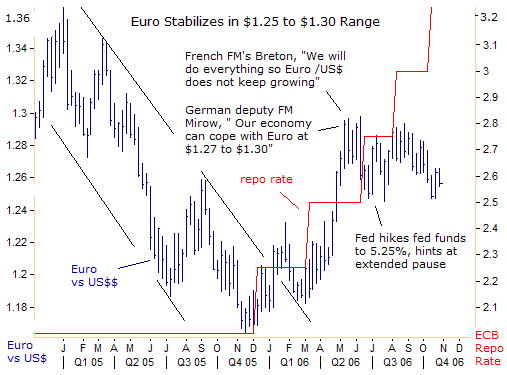
For the past six months, the Euro, Japanese yen, and British pound have been remarkably stable against the US dollar, locked into a 4% to 5% trading ranges. So the big question is: How did the big-4 central banks and their finance officials pull off such remarkable currency stability, at a time of enormous global trade imbalances, and 10% to 25% swings in global commodity and stock markets?
Recent history in the Euro, Yen and Sterling
The Euro’s last major move in late-April thru mid-May, and extended from $1.21 to a high of $1.30, before coming to an abrupt end, when top European finance ministers objected to further gains above $1.30. On May 16th, French Finance Minister Thierry Breton, said the French economy could tolerate the Euro’s rally to $1.30, but, "We must be very attentive to exchange rates. We will do everything so that this difference between the Euro and US dollar doesn’t keep growing.”
Breton was backed-up by verbal jawboning from Bank of France chief Christian Noyer on May 16th. "Big movements in the foreign exchange market could hamper economic growth in the Euro area, and run exactly contrary to G-7 efforts to rebalance the global economy. So certainly, this is not something that is warranted. The clear consensus in the G-7, is that there should not be any correction between the dollar and especially the Euro and other European currencies,” Noyer warned.
Then on May 21st, German Deputy Finance Minister Thomas Mirow added, "We don’t see problems from a rising Euro for us because of the nature of our exports,” driven by technology companies competing in high-end, high quality markets. “Still, we do not want to see abrupt changes of exchange rates. So at the Euro level of $1.27-$1.30 we esteem that there are no acute problems for Germany,” he added.
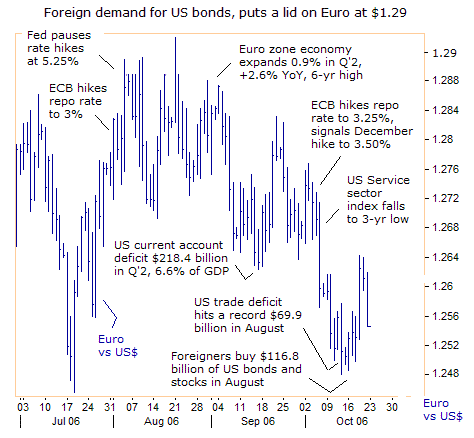
As if by magic, the Euro obeyed the whims of the Group of Seven, stabilizing within a tight range between $1.25 and $1.30. The Euro did attempt a break-out rally towards $1.30, after the Federal Reserve paused in its 2-year rate hike campaign at 5.25% on August 8th. With the Fed on the sidelines, the European Central Bank lifted its repo rate twice to 3.25%, and telegraphed a third hike to 3.50% in December, which in theory, should make the Euro more attractive.
Instead, the Euro did a U-turn, tumbling from a high of $1.2939 on August 21st to as low as $1.2480 on October 13th. The reason for the Euro’s slide didn’t become apparent until October 17th, when the US Treasury said foreign demand for US bonds and stocks had soared to $116.8 billion in August from $32.9 billion in July, far higher than the monthly US trade deficit of $69.9 billion.
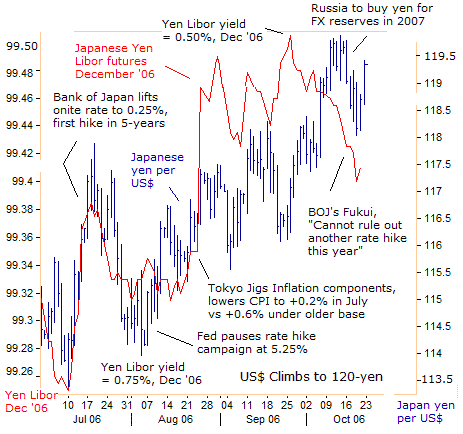
Against the Japanese yen, the US dollar bottomed out at 114-yen on August 8th, within minutes of the Fed’s announcement of a pause in its rate hike campaign. The US$ climbed 5-yen in a see-saw pattern to as high as 119.88-yen on October 13th. Japanese investors were net buyers of $7.6 billion of US Treasuries in August, their largest purchase in 14-months, anxious to lock in 5% yields on US long bonds.
But the dollar received its biggest boost against the yen from Tokyo’s sleight of hand on August 25th, when Japanese apparatchniks re-jigged the consumer price index, and revised the inflation rate lower by two-thirds from the previous calculation. That handcuffed the Bank of Japan (BoJ), and ignited a rally in Japanese yen Libor futures to 99.50 from 99.34, which effectively ruled out a BOJ rate hike in Q’4.
The US dollar hit resistance at the psychological 120-yen level on Oct 13th, when BoJ chief Toshiro Fukui hinted at a rate hike, despite Tokyo’s re-jig of the inflation data. “If you ask me whether there’s a possibility of another rise in interest rates within this year, I cannot deny that possibility,” he warned. Then on October 16th, Russia’s central bank said it planned to convert some of its $267 billion of foreign currency reserves into Japanese yen, triggering dollar sales below120-yen.
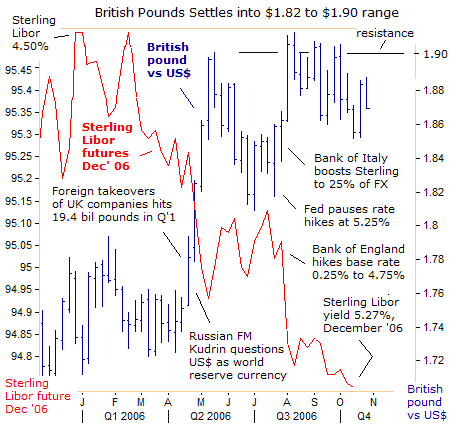
Russia’s finance chief Alexei Kudrin ignited a big rally for the volatile British pound in late April, when he questioned the US$’s status as the world’s reserve currency. Speculators jolted the British pound from $1.74 to the $1.90 psychological level on May 14th, where the currency has been capped for the past six months. The Bank of Italy announced on August 3rd, that it had boosted sterling to 25% of its $79 billion in FX reserves, briefly lifting the pound to $1.91, where it ran into a brick wall.
The British pound is a favorite among currency speculators, because of the Bank of England’s “hands-off” policy. Last week, the BoE received the green light to hike its base rate by 0.25% to 5.00% on November 9th. UK Treasury minister Edward Balls signaled on October 20th. “With the economy growing more strongly than expected and with upward pressure on global commodity prices we must all remain vigilant. We need continued discipline in wage-setting and pay-bargaining across the private and public sectors,” he said.
How the US$ defies the Law of Gravity
The giant US trade deficit has generated a huge outflow of dollars, and behind-the-scenes strategies to bring the money back home. For the first eight months of 2006, the US trade deficit rose to $522.9 billion, and is likely to exceed the 2005 shortfall of $726 billion. Such a sea of red ink suggests the US dollar is still overvalued on a trade weighted and prone to a further devaluation.
Nearly a third of the US trade deficit in August was with China, widening to a record $22 billion, and twice the $11-billion deficit posted with the European Union, and three times the $7.5-billion US deficit with Japan. By the end of September, China’s global trade surplus was at $110.9-billion this year, surpassing the annual record of $102-billion set in 2005, and on course to reach $150 billion in 2006.
China’s trade surpluses with the European Union of $127 billion and with the US of $202 billion in 2005, enabled it to become the world’s third largest trading nation, exporting and importing about $1.4 trillion worth of goods and services a year. Robust exports and bank loan growth of 15.2% have defied planners’ efforts to rein in economic growth, projected at 10.5% for this year.
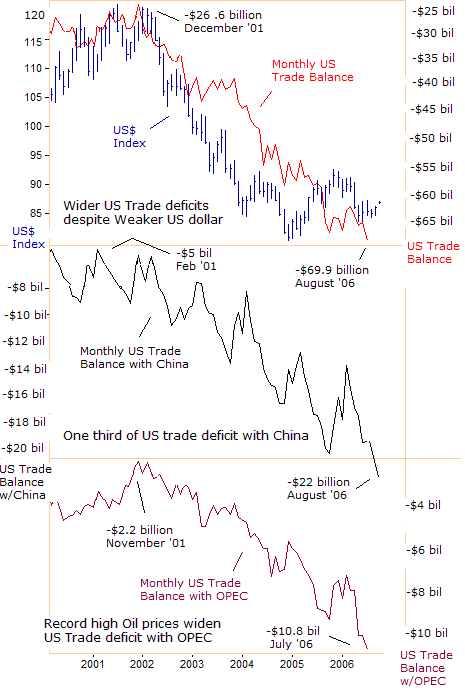
Under the Bush administration, the US trade deficit has mushroomed from about $26 billion per month in 2002, to as high as $70 billion in August 2006. The US dollar’s 30% devaluation against a basket of currencies since 2002, including the Euro, British pound, Canadian dollar, and Japanese yen, did catapult US exports to a record high of $122.4 billion in August ‘06, but import growth was still stronger at $192.3 billion, and generating record US trade deficits.
The US trade deficit remains stubbornly high, partly because the undervalued Chinese yuan pushes up imports of Chinese goods and handicaps US exporters of durable goods and high-end services. Also, record high oil prices boosted US oil imports to $27.2 billion in August, and the world’s biggest economy was on course for a whopping $320 billion oil bill this year, until the latest plunge in oil prices.
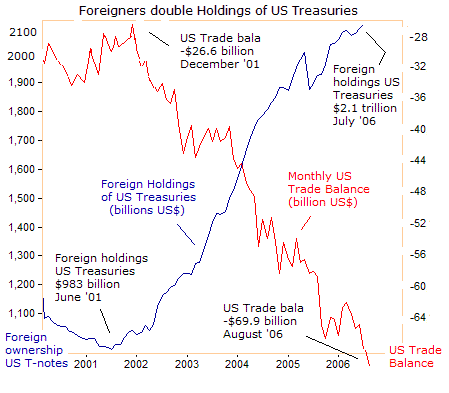
Financing the US external deficit requires increasing agility. Every business day requires $3.5 billion of net new money to enter the US markets, to prevent the US dollar from falling under its own weight. Most of that money comes from Asian central banks and Arab oil producers, which own large amounts of dollars.
Japan is the largest holder of $644.2 billion of US Treasuries, and China is the second-largest holder with $339 billion. London based brokers added $11.1 billion of US Treasuries to their clients’ portfolios in August, including members of OPEC, to a record $210.4 billion. Overall, foreigners now own $2.14 trillion, or 46% of the $4.5 trillion of marketable US Treasuries.
The US Treasury’s Secret agreement with Beijing
The Bush administration’s dealings with Beijing are simple, free Chinese access to US consumer markets, and acceptance of the undervalued yuan, in return for massive Chinese purchases of US bonds. China is loath to increase the yuan enough to dampen growth in its coastal factories. Exports are a key source of jobs in a country that must employ tens of millions of poor farmers and workers laid off by bankrupt state factories, in the continued transition from communism to capitalism.
The Chinese central bank prints yuan in exchange for the foreign currency flowing into the country, and in the process, has increased its M2 money supply by 18% for the past few years. Beijing added $169-billion to its foreign currency reserves in the first nine months of this year, which will soon top $1 trillion, the world’s largest. Beijing’s satellite, the Hong Kong Monetary Authority said its foreign currency reserve assets rose $1.4 billion to $130.3 billion in September.
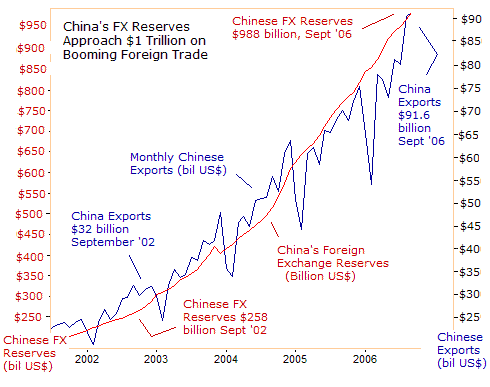
China purchased more than $200 billion in US and other foreign debt last year, equal to 9% of its economic output and about 25% of its exports. China has recycled about 70% of its $988 billion foreign currency reserves into US Treasury and other government agency debt, helping to keep US mortgage rates artificially low. In return, the Bush administration killed the Schumer-Graham bill that would have slapped a 27.5% tariff on Chinese imports into the US.
Beijing has limited the yuan’s gains to 2.1% since it ended the rigid dollar peg in July 2005, and is expected to limit the dollar’s decline to 3% this year, to minimize losses to its massive US bond portfolio. Yu Yongding, an adviser to the central bank has warned, “China’s economy would take a big hit if the US dollar weakened sharply due to such factors as a bursting of the US property bubble. The loss for China’s foreign exchange reserves would be extremely serious.”
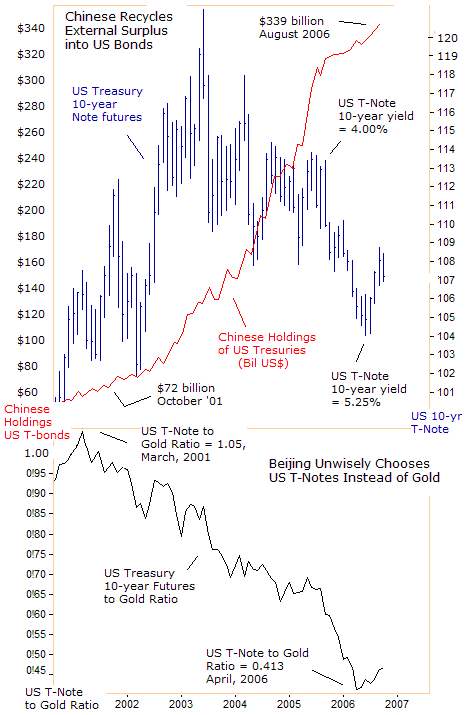
Subsidizing its exports with an undervalued yuan has allowed China’s cargo trade to reach about 56% of the level of the United States and 82% of Germany’s. But Beijing is paying a heavy price in its trade dealings with the Bush administration. The purchasing power of US Treasury notes in relation to gold has dropped in half from four years ago, making it much more expensive for Beijing to switch its reserves from US debt to gold. Beijing holds only 1.5% of its FX reserves in gold.
And the million dollar question in the foreign exchange and gold markets is how will Beijing manage its bloating reserves in the years ahead? China’s FX reserves are on track to hit the $1.5 trillion mark in the second quarter of 2008, and might hit $2 trillion by the end of 2010. Last month, China tapped into its reserves, importing a record 13.2 tons of crude oil, up 24% from a year earlier, and not including 3 million barrels of Russian crude that was pumped into storage tanks south of Shanghai.
After the Bush economic team departs, China might find a tougher US president or a Democratic Congress, that aims to reverse the massive transfer of wealth from the US to China, but could steer Beijing away from the US dollar. However, such a scenario is at least 2-years away, and no change is expected in the gentleman’s agreement between the US Treasury and the People’s Bank of China until then.
Japan Targets US dollar for Nikkei Exporters
Japanese investors have $14 trillion in savings, and earn more from interest and dividends on investments held overseas, than from foreign trade. Japan’s current account surplus rose 22.2% in August from a year earlier to 1.48 trillion yen ($12.3 billion) earning 1.16 trillion yen from overseas investments, dwarfing a trade surplus 312.4 billion yen. Japanese investors were net buyers of 16 trillion yen ($140 billion) of foreign bonds in 2005, but avoided the US Treasury market.
The Bank of Japan affixed its reputation as the world’s second leading interventionist bank, when it sold 35 trillion yen in exchange for $315 billion US dollars, mostly between 105-yen and 112-yen, in late 2003 thru March 2004. The BoJ plowed the US dollars into US Treasuries until August 2004, when its holdings peaked at a record high of $699.4 billion. Thus, Tokyo is the world’s biggest “yen carry” trader.
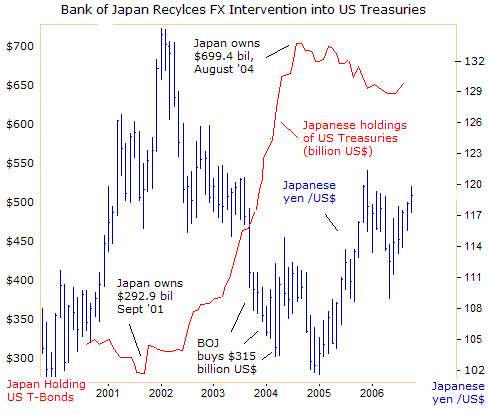
Tokyo skillfully unwound $50 billion of its “yen carry” trade over the past two years, without disturbing the US dollar’s uptrend to 120-yen. Tokyo depends on the US dollar’s 5% interest rate advantage over Japanese Libor rates, to enable the dollar to bounce back from periodic sales of US Treasuries. Still, Tokyo holds onto the bulk of its US Treasuries, to maintain cordial relations with its military protector, especially while under nuclear threat from North Korea’s Kim Jong-il.
Japan’s ministry of finance and the US Treasury might have a secret target zone for the dollar /yen, and when the US$ approached 120-yen on October 23rd, Japan’s top financial diplomat, Hiroshi Watanabe told reporters in New York, “I see no reason for a further deterioration in the yen given the strength in the Japanese economy.”
Arab Oil producers Recycle Petro-dollars thru London
The Institute of International Finance, an umbrella group for 340 of the world’s private-sector banks, predicted in August that high oil prices would lift the current account surpluses of six Gulf Arab states to $230 billion this year, or 30% of their gross domestic product. The bulk of the surpluses in Saudi Arabia, the United Arab Emirates, Kuwait, Oman, Qatar and Bahrain, are re-cycled into their already large private and official foreign assets, such as in British gilts and US Treasuries.
The six Gulf countries, all with currencies pegged to the dollar, are working towards monetary union by 2010, but will initially peg their future common currency to the US dollar. “It makes sense for the Gulf States to peg its currencies to the dollar since the oil market is priced in dollars,” said Sheikh Ahmed bin Mohammed Al Khalifa, the Bahraini Minister of Finance on October 19th.
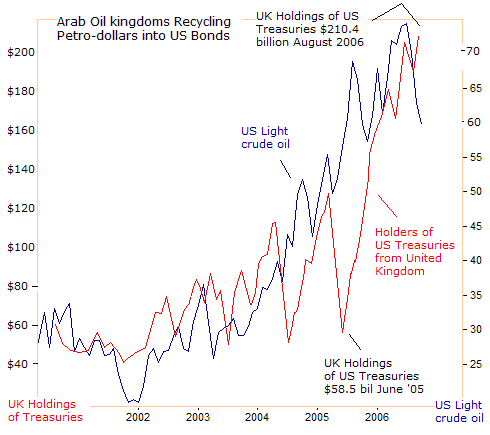
Amid soaring oil prices, holdings of US Treasuries through London based brokers quadrupled in just fourteen months to a record $210.4 billion in August ’06, probably on behalf of Middle Eastern investors. Only the UAE’s central bank has signaled a desire to convert 10% of its largely dollar-denominated foreign exchange reserves into Euros and gold, but is waiting for a dip in the Euro before making the switch.
Shifting Fortunes, Brazil is a buyer of US Bonds
The four year boom in commodities prices to 25-year highs has been a bonanza for Brazil’s economy, the largest in Latin America. Brazil’s exports reached $76.9 billion thru the first seven months of this year, an increase of 14.7% from the same period in 2005, netting a trade surplus of US$25.82 billion. The Bank of Brazil has been a daily buyer of US$’s from exporters, who desire the higher yielding Brazilian real.
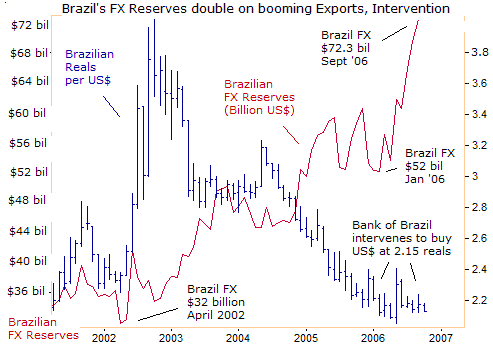
Brazilian central bank’s FX reserves have jumped by $20 billion to $72.3 billion this year. Brazilian-based traders added $11.5 billion of US Treasuries in August, boosting their holdings to $43.2 billion, making the country the 11th largest holder of US debt. Brazil’s finance ministry does not want to see the US dollar fall below the psychological 2.0 real level, which could badly hurt its exporters, especially in light of the recent drop in commodity prices.
But the strong Brazilian real has also exerted downward pressure on the benchmark IPCA consumer inflation index, which the central bank uses as a guide to set interest rates. Consumer inflation rose 3.7% in the 12-months through September, the slowest pace since a 3.32% rise in the year through June 1999. Inflation is below the central banks target of 4.5% for 2006.
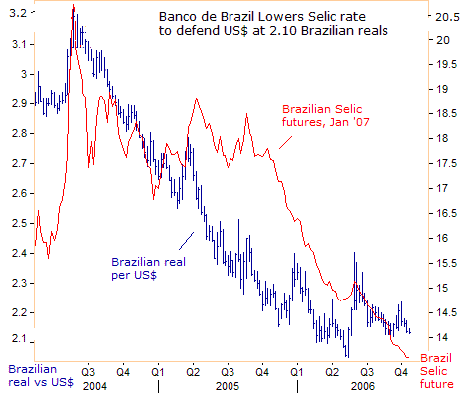
On October 19th, Brazil’s bank’s nine-member monetary policy committee, led by its President Henrique Meirelles, voted unanimously to cut the so-called Selic rate, to 13.75% from 14.25%, extending the longest period of monetary easing in the country’s history. Borrowing costs have fallen by 6% from 19.75% in September 2005, partly in a bid to prevent the US dollar from falling under 2 Reals.
Still, currency traders are likely to favor the Brazilian currency, which carries a positive rate of return of 10%, adjusted for inflation. That in turn, forces the Brazilian central bank to continue its daily intervention on behalf of the US$, and rolling-over the proceeds into US Treasury bonds. Banco de Brazil might choose to cut its Selic rate further at its next meeting on November 29th.
Russia is an Outspoken Bear on the US dollar
Record oil prices combined with record Russian oil exports, have boosted the Kremlin’s foreign exchange reserves to a record $267 billion this year, outstripped only by those of China and Japan. In August, Russia paid back $22.5 billion debt to the Paris Club of creditor nations, and with its foreign debt standing at just $108 billion, S&P raised Moscow’s foreign bond rating to BBB+.
It represents a spectacular transformation from the financial meltdown in 1998 when Russia defaulted on its debt and the rouble crashed. Booming crude oil, base metal and other commodity prices lifted Russia’s foreign trade surplus to $86.2 billion in the first half of 2006 from $66.3 billion in the same period a year ago.
With its reserves swelling from petrodollar inflows, strong current account surplus and booming economy, Russian kingpin Vladimir Putin ordered the full convertibility of the rouble in July, and launched trading of Russian oil, refined products and commodities on local bourses in roubles. Russia was accumulating $10 billion of foreign exchange a month until July, and the central bank bought more than $100 billion from the currency markets this year to slow the appreciation of the rouble.
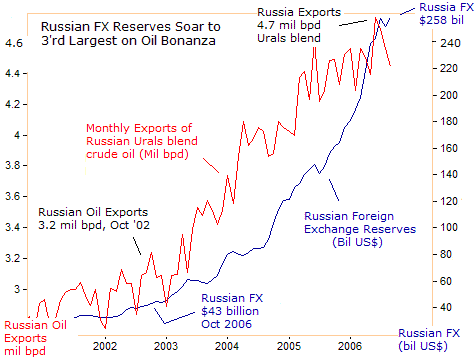
But Moscow remains a vocal bear on the US dollar, bucking the strategy of other central banks in China, Japan, or Brazil. Instead, Moscow has steadily reduced its dollar holdings from three years ago. Sergei Ignatyev, the central bank chief, said that about half of bank’s reserves were held in US dollars, with the bulk of the rest in Euros. He indicated the yen would be increased as a proportion of the total reserves, and Russia would build positions in the Australian and Canadian dollars.
Federal Reserve Underpins US$ with high fed funds rate
In order to attract $3.5 billion each working day from Asia, Europe, and the Persian Gulf, the Federal Reserve lifted the fed funds rate to 5.25% to discourage dumping of the dollar. The fed funds rate is pegged 5% above Japan’s overnight loan rate, 2% above the ECB’s repo rate, and a half-percent above the Bank of England’s base rate, even at the risk of sinking the US housing market.
Russian finance minister Alexei Kudrin dropped a bombshell on the dollar in April 2006, wiping out half of it’s gain from the previous year. “The US dollar is not the world’s absolute reserve currency. The unsustainable US trade deficit is causing concern, and the international community can hardly be satisfied with this instability,” he declared to members of the IMF in Washington.
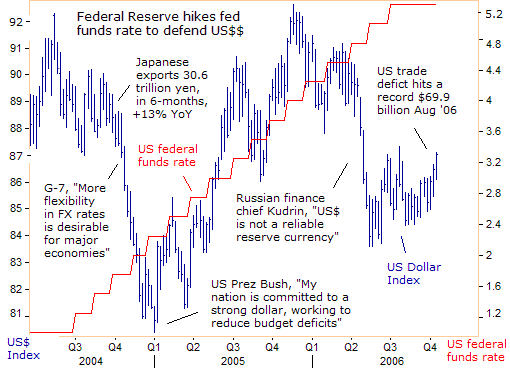
Kudrin’s remarks touched off a mini-free fall for the US dollar index to the 84-level, in Q’2, forcing the Fed to hike the fed funds rate by another half-percent to 5.25% in June, to stabilize the dollar. The Russian central bank vexed the Fed for a second time on October 18th, when it vocalized its intention to convert US$ into yen. The Federal Reserve understands that it cannot afford to ease its grip on interest rates in the fourth quarter, without triggering a speculative attack against the US dollar.
On October 4th, Federal Reserve Vice Chairman Donald Kohn challenged expectations that Fed rate cuts will occur anytime soon. “I am surprised at how little market participants seem to share my sense that the uncertainties around inflation and their implications for the stance of policy are fairly sizeable at this point,” he warned.
Philly Fed chief Charles Plosser was more hawkish, “The housing sector is going through a painful, but necessary adjustment. But the expansion is still on firm footing and growth is likely to accelerate in 2007. We need to remain vigilant and maintain the current policy, or even firming further, in the best interests of the economy’s long-run performance. The predominant risks facing the economy now are on the inflation side,” he warned on October 6th, ruling out Fed rate cuts in Q’4.
But at some point however, the Fed may have to confront the unenviable task of defending the US dollar or US home prices. Now that the fed funds rate has settled at 5.25%, US dollars bears such as the Russian central bank, are acting before the earliest clue that the Fed is about to lower the fed funds rate.
“Tricky” Trichet makes US dollar look less Ugly
The European Central Bank raised interest rates for a fifth time on October 5th, to 3.25%, the highest level in almost four years, and telegraphed another hike in December to 3.50% to combat inflationary pressures. ECB chief Jean “Tricky” Trichet avoided any clear message on where rate moves are headed after that, but said, “Our monetary policy remains accommodative. If our baseline scenarios are confirmed it will remain warranted to further withdraw monetary accommodation.”
The Euro M3 money supply and loan growth accelerated in August, driven by a surge in new loans for corporate mergers and takeovers. The 12% annual increase in business lending was the highest since September 2000. The M3 money supply measure jumped 0.4% to an annualized growth rate of 8.2%, far above the central bank’s long discarded 4.50% target rate.
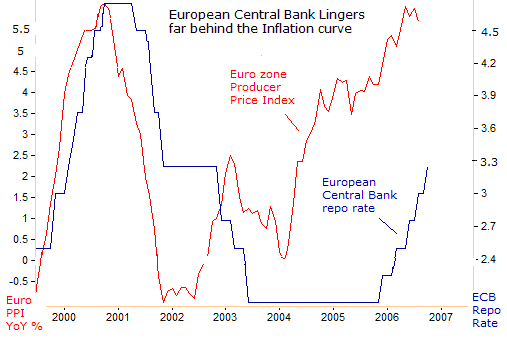
But “Tricky” Trichet’s rate hikes are deceiving, because they are pegged far below the Euro zone’s producer inflation rate. Negative interest rates have spawned European mergers and takeovers to the tune of $1.2 trillion in the first eight months of 2006. The ECB can’t control the M3 money supply, when borrowing is expanding at such a rapid clip, and negative interest rates in Europe, enable the ECB to covertly make the US dollar look less ugly in the foreign exchange market.
Bank of Japan working behind the Scenes
Tokyo has a lot of experience in battling foreign currency speculators, when the dollar sinks against the Japanese yen, and threatening the best interests of Nikkei-225 exporters. Yet the BoJ appeared to be facing a mission impossible, trying to dismantle its five year super easy money policy on one hand, without crushing the US dollar against the Japanese yen with the other hand.
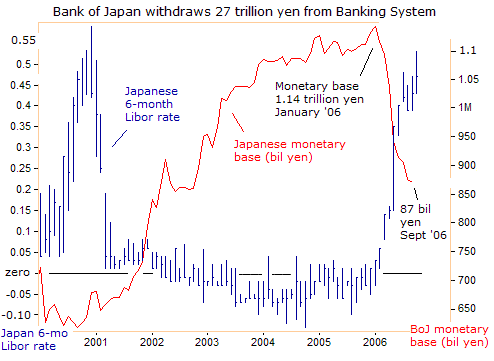
The Bank of Japan has withdrawn 27 trillion yen from the banking system since March 9th, and lifted its overnight loan rate above zero percent on July 14th. Previously, the BoJ was flooding its banking system with an excess of 26 trillion yen above the reserve requirements of local banks, which often submerged the six-month Yen Libor rate below zero percent from 2003 through 2005.
The US dollar did go into a mini meltdown against the yen in late April thru early may, plunging 10-yen to as low as 109-yen, as the BoJ moved aggressively to drain excess yen out of the banking system. But Tokyo’s financial warlords went into action when the dollar fell towards 110-yen, with a predictable barrage of jawboning, peppered with threats of outright intervention in the currency market.
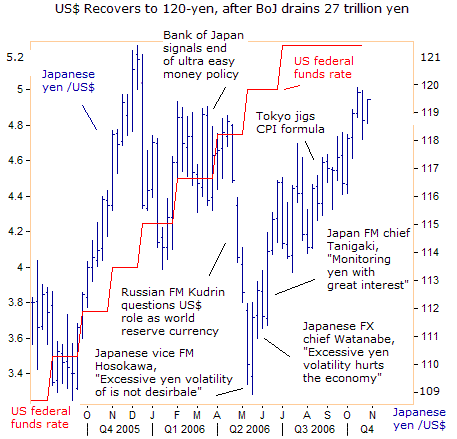
Tokyo received valuable outside help from the Federal Reserve, which hiked the fed funds rate on two occasions to 5.25% since March 9th. Tokyo then rigged the components in its consumer price index on August 25th, handcuffing the BoJ from further rate hikes in the fourth quarter. That was the icing on the cake, which enabled Tokyo to restore the dollar to its previous position of 118 to 120-yen.
The Bank of England’s Radical Monetary policy
The Bank of England has tried to cap the British pound at $1.90, by keeping its base rate exactly where it was at the start of 2005. The BoE also tolerates an explosion of the British money supply that is more characteristic of emerging economies in China and India. The UK’s M4 money supply surged to a 14.5% annualized growth rate in September, its fastest rate in 16-years, setting-off alarm bells in London.
But time seems to be running out for the BoE’s ultra easy money policy. The UK economy grew by 0.7% in the July-September period, lifting the annual rate of expansion to 2.8%, the fastest pace since the third quarter of 2004. That seems to cement the case for a quarter-point BOE rate hike to 5.00% on November 9th. BoE chief Mervyn King warned on October 10th, “That decision will be taken only in November, and much can change between now and then.”
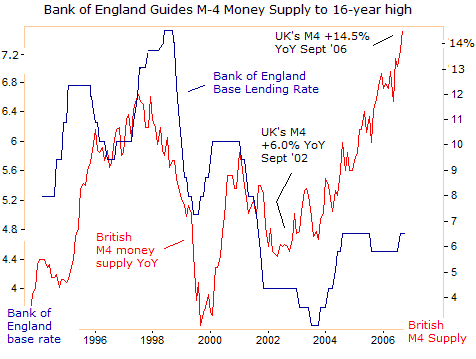
From 1997 through 2003, the Bank of England closely monitored its benchmark M4 money supply, adjusting its base rate higher to counter strong M4 growth, and lowered rates when the money supply slowed. However, the BoE abandoned the discipline of monetarism over the past two years, and has lost control of the money supply, which now threatens the UK economy with an inflationary surge.
British interest rates are far too low to curb borrowing or the velocity of the money supply. Net mortgage lending rose by 6.2 billion pounds in August, up from the monthly average rise of 5.4 billion over the previous six months, and beating the last record set in April 2004, when it increased by 6 billion pounds. Asking prices for UK homes in the four weeks through October 7th rose to 338,000 pounds, or 11.5% higher from a year earlier, the biggest annual gain in two years.
The BoE’s Andrew Sentance said inflation could slip in the short term because of lower energy prices, but rising wages present a problem. “In terms of inflation, there is the risk if we have continuing inflation above target that it does begin to feed into wage increases. That’s a significant worry,” said Sentance. UK wages including bonuses grew an annual 4.4% in the quarter through July.
Quizzed on the importance of M4’s 14.5% expansion, “The recent growth in M4 could ultimately have an impact on the economy. I view this as an issue of concern about the future path of inflation,” said BOE member Timothy Besley. Sentance said the 14.5% M4 growth rate, the fastest since 1990, was an “amber light”.
The New Zealand dollar offers Interesting Insights
It would be far fetched to put the New Zealand dollar, (kiwi) in the same league as the world’s top-4 reserve currencies. Still, currency traders are often attracted to its high yield, but lose sleep over its huge external deficits. The kiwi has been on a rollercoaster ride in 2006, amid shifting expectations over the direction of NZ Libor rates and the ability of the NZ economy to sustain high interest rates.
The Kiwi is buoyed by the Reserve Bank of New Zealand’s (RBNZ) 7.25% cash rate, which is 2% above the US fed funds rate and 7% higher than the Bank of Japan’s overnight loan rate. But the NZ current account deficit widened to NZ$15.2 billion ($US10 billion) in the year ended June 30th, equivalent to 9.7% of gross domestic product. The compares to South Africa’s 6.4% c/a to GDP ratio of 6.4%, which encouraged traders to hammer the South African rand by 25% this year..
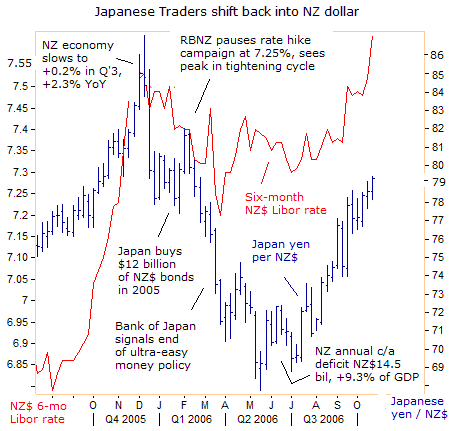
Ten months ago, the kiwi began a 20% devaluation against the Japanese yen, on news that NZ’s economy had ground to a halt in the third quarter of 2005. On January 26th, the RBNZ halted its two year rate hike campaign at 7.25%, and while it reiterated that it saw no scope for an easing, it added, “We do not expect to raise the official cash rate further in this cycle. However, this possibility cannot be ruled out until we see clear evidence of a sustained weakening in domestic demand.”
Anticipating a peak in NZ Libor rate and an RBNZ easing cycle in 2007, Japanese traders rushed to unwind the “yen carry” trade. The Bank of Japan started to dismantle its ultra-easy money policy, ultimately draining 27 trillion yen out of the Tokyo money markets. Japanese investors, who had bought NZ$12 billion of NZ bonds in 2005, started dumping the kiwi, after NZ Prime minister Helen Clark applauded the kiwi’s devaluation.
Yet the kiwi stabilized at 70-yen in the summer of 2006, when traders began to have second thoughts about the inevitability of RBNZ rate cuts this year. Last month, RBNZ chief Alan Bollard insisted that he wouldn’t cut rates for “some considerable time because inflation hasn’t abated”. Consumer prices rose 4% in the year ended June 30th, above the central bank’s 1 to 3% target. Kiwi Libor rates climbed to 7.62% last week, discounting an RBNZ rate hike to 7.50% on October 26th.
Japanese traders are once again, playing the “yen carry” in the both the NZ kiwi and the US dollar. Interest rate differentials are a powerful draw in the foreign exchange markets, even for currencies with chronically high external trade deficits.
“The world economy is doing miraculously well,” said former Fed chief Paul Volcker on October 17th, because “there are some big imbalances underneath all of this, especially the flow of capital into the US. If the music stopped or slowed down a bit in terms of the foreign money coming into the US, you’ve got a potential problem for the US dollar and inflation,” Volcker warned.
** If you enjoyed this article, consider a subscription to the Global Money Trends newsletter published on the 1st and 15th of each month in pdf format, and 20-25 pages in length. GMT collects a wide array of news and information from reputable sources, filters out the noise and distractions, and puts all the pieces of global economic puzzle together into coherent snapshot analyses, with lots of cool charts depicting the inter-relationships of markets and economies around the world.
Here's what you will receive with a subscription,
Insightful analysis and predictions of, (1) top stock market indexes around the world, and US-listed Exchange Traded Funds (ETF’s) and closed-end country funds. (2) Commodities such as crude oil, copper, gold, silver, the CRB index, and gold mining and oil company indexes. (3) Foreign currencies such as, the Australian dollar, British pound, Euro, Japanese yen, and Canadian dollar. ($) Libor interest rates, global bond markets and their central bank monetary policies.
A subscription to Global Money Trends is $120 US dollars per year for 24 issues, including access to all back issues. Click on the following hyperlink, to order now, http://www.sirchartsalot.com/newsletters.php
© 2005-2022 http://www.MarketOracle.co.uk - The Market Oracle is a FREE Daily Financial Markets Analysis & Forecasting online publication.



